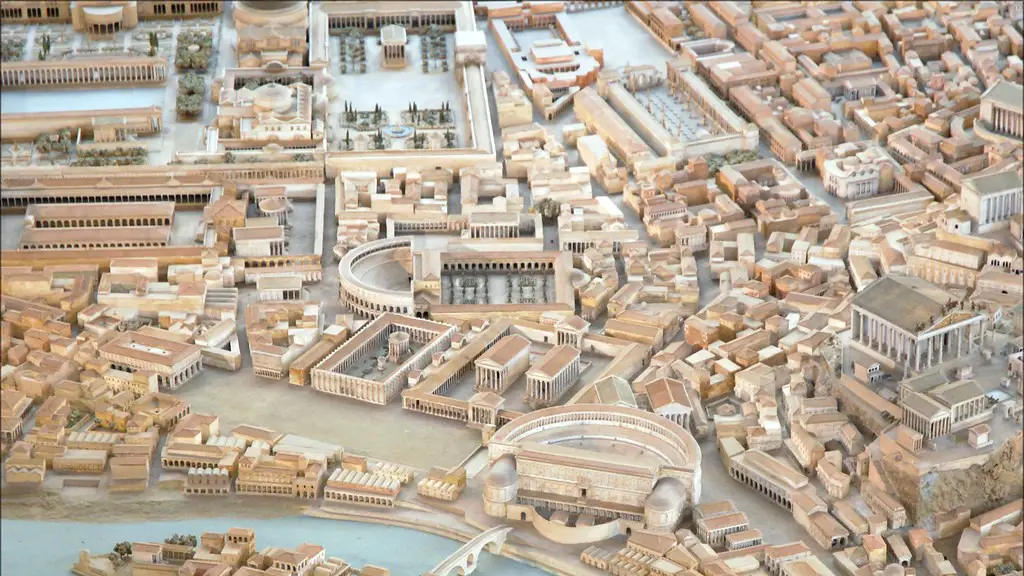Historic Context
Ancient Rome was a powerful empire, built on a complex network of cultures, trade, and beliefs. This grand civilization was a formidable force with a deep understanding of the forces of nature, a sophisticated system of engineering, and a well-developed legal system. They understood the importance of technology and its application to the advancement of their society. From this, Rome’s advanced technology enabled the grandiose sculptures, majestic architecture, and awe-inspiring engineering projects that we still marvel at today.
As Rome expanded its reach, it was necessary to build roads, aqueducts, fortifications, weapons, and war machines. By adopting new technologies to meet the demands of their expanding empire, Rome created some of the most powerful weapons of the ancient world. Technology also played an important role in Rome’s political system. By harnessing the immense power of the written language and engineering skills, Rome was able to develop complex systems of communication that allowed their citizens to stay connected.
At the same time, Rome’s political structure was supported by technologies that allowed them to effectively manage their resources and govern the large population. Technology was also essential in the agricultural sector, providing the agricultural tools and irrigation systems needed to produce enough food for the enormous population. Additionally, technology, in the form of aqueducts and transportation, was employed to manage water supplies, distribute goods, and facilitate travel.
Impact on Writing and Communication
Technology in ancient Rome played a crucial role in the development of writing and communication. The Romans adopted the Greek alphabet, transforming it into the Latin alphabet we still use today, and developed a written language that was easier to understand and use. This allowed them to record their history, legal system, and government and religious systems in an organized and efficient way.
The development of writing and communication also impacted Rome’s decentralized government, which relied on correspondence between censors, governors, and other officials to make decisions. Technology allowed these officials to exchange messages, gather resources and materials, plan construction projects, and coordinate activities over long distances. This allowed them to effectively govern the immense reaches of their empire.
Engineering and Architecture
Technology was essential in the production of some of Rome’s most impressive engineering and architectural achievements. Rome’s architecture and engineering were based on a combination of knowledge, skill, and imagination. Many of the grandiose structures we still appreciate today, such as the Colosseum and the Pantheon,would not have been possible without the tools and techniques Rome had developed.
The Romans had a tremendous understanding of architecture and engineering, which allowed them to build incredible monuments and public works. They understood the importance of materials and tools, and their ability to manufacture and equip them with the necessary resources was key to the success of their projects. Rome’s engineering and architecture were a product of their sophisticated understanding of mathematics and physics, and the technical skills acquired from other civilizations.
Tools and Equipment
In order to build and construct the large structures and monuments Rome is known for, it was necessary to obtain and develop many tools and equipment. Rome developed a variety of sophisticated tools and equipment, ranging from stone-cutting tools to powerful machines. In addition, they had specialized tools and machines to build roads, aqueducts, and other structures.
The Romans also developed new production processes to create building materials. They developed the process of cementation, which was the process of combining different materials to create a stronger material. Rome also developed specialized machines that allowed them to cut stone or other materials into precise shapes, giving them an advantage over other civilizations.
Military Weapons and Tactics
Rome was an ancient superpower and conquered many lands through its powerful military weapons and tactics. The Roman army was renowned for its organization, structure, and discipline, as well as its innovative weapons and tactics. The Romans developed sophisticated military weapons and implemented tactics that were difficult for its enemies to counter.
For instance, the Romans developed rams, which were large wooden machines used to break down the walls of enemy fortifications. Rome also developed catapults and other siege engines, which could launch projectiles from a long distance and cause great destruction. The Romans developed tactics such as the phalanx formation, where a group of infantry stood in close proximity and used their shields in a shield wall formation to protect themselves from attack.
Conclusion
Technology played an essential role in the development of the Roman Empire and in the advancement of Roman society. From engineering and architecture to agriculture and the military, Rome utilized technology to create powerful weapons, increase their wealth, expand their empire, and secure their power. It is clear that Rome was a civilization that understood the importance of technology and used it to their advantage.

